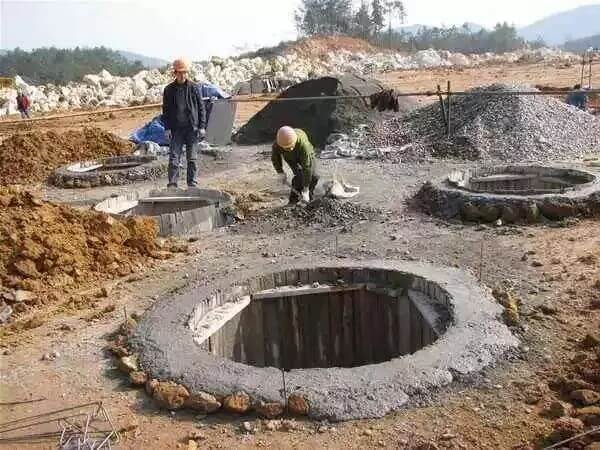According to the characteristics of the pile and the vertical force, the pile foundation can be divided into two categories: friction pile and end-bearing pile. In construction, only by fully understanding and distinguishing the two types of pile foundations can the construction of pile foundations be completed better. The distinction can be made from the following four aspects:
1. Definition difference:
End-bearing piles refer to piles in which the vertical load on the top of the pile is borne by the pile side resistance and the pile end resistance, but the pile end resistance bears more. The pile end generally enters the sand or gravel soil layer with medium density or above, or is located on the top of medium-weathered, slightly weathered, and fresh bedrock.
Although the side friction resistance of this type of pile is secondary, it cannot be ignored. End-bearing piles are a type of pile. It refers to piles in which the pile body passes through soft soil layers, the pile end is set in dense sand or gravel soil layers, or is located on the top of medium-weathered, slightly weathered, and unweathered hard rocks. Most of the vertical load on the top of the pile is borne by the pile end resistance, and the pile side resistance is very small and can be ignored.
Friction piles refer to piles in which the vertical load on the top of the pile is borne by the pile side resistance and the pile end resistance, but the pile side resistance bears more load. Generally, the bearing layer at the end of a friction pile is mostly solid clay, silt, and sand, and the aspect ratio of the pile is not very large. Friction piles are a type of pile, which refers to a pile in which most of the vertical load on the pile top is borne by the pile side resistance, while the pile end resistance is very small and can be ignored.
2. Differences in construction:
The pile relies on friction and end resistance to bear the top load. Friction is the resistance between the pile body and the rock and soil around the pile when the pile body is elastically compressed and displaced downward after bearing the top load.
End resistance is the pile end (pile bottom) placed on the rock and soil layer with relatively high strength (also called the foundation bearing layer). When the top load of the pile is transmitted to the pile end, the rock and soil layer under the pile end bears the load.
It can be seen that the difference between friction pile and end-bearing pile construction should be noted: when constructing end-bearing piles, the structure and strength of the soil at the pile end should not be disturbed or destroyed, and efforts should be made to protect the strength of the soil at the pile end. Do not let the soil at the pile end be eroded by water. The loose soil and scum at the pile end must be cleaned up, otherwise, the pile will sink.
The pile end should be made flat or stepped, without slopes, and loose stones in the rock at the pile end should be removed. When constructing friction piles, it is necessary to protect the friction resistance and strive to increase the friction resistance, make the soil wall around the pile rougher, do not disturb or destroy the structure and strength of the soil around the pile, do not let the soil around the pile be eroded by water, etc.
3. Differences in geological verification after drilling:
After drilling the pile foundation, a geological verification must be carried out to check whether it is consistent with the designed geology. During the drilling process of the end-bearing pile, a slag sample is taken every 2m. In places where the geological changes are relatively large, a sample is taken every 50cm as the basis for geological verification after drilling.
The geological verification after drilling requires that the first pile of each pier must be attended by the design institute personnel, and the construction unit personnel and the supervision unit personnel must be present to conduct geological verification. The verification content includes changes in geological conditions, on-site confirmation of slag samples, and the depth of entry into the rock (that is, the depth of entry into the last layer of rock). If the geological conditions are consistent with the design and the depth of entry into the rock meets the design requirements, the next step of construction can be carried out. If the above conditions are not met, it is necessary to continue drilling or make design changes.
Only the first pile of each pier is attended by the design institute personnel. During the construction of the remaining pile foundations, only the construction personnel need to make records, the supervision personnel need to witness, and then send the results to the design institute, but the image data must be retained.
During the drilling process of friction piles, slag samples are taken every 2m. In places where geological changes are relatively large, samples are taken every 50cm as the basis for geological verification after drilling. However, the friction pile design institute will come to the site once every eight bridge piers to conduct an on-site comparison to see whether the design is consistent with the actual situation. If not, the design will be changed. Generally, as long as the geological conditions do not change significantly, friction piles can be constructed normally.
4. Difference after hole cleaning:
After the pile foundation is bored, the steel cage is lowered, the conduit is installed, and the hole cleaning begins. After the hole cleaning, the two types of piles have the following similarities: the mud-specific gravity is not more than 1.1; the sand content is not more than 2%; the viscosity is 17-20s. However, the biggest difference between end-bearing piles and friction piles is the sediment thickness, which is: ≤5cm for end-bearing piles; and ≤20cm for friction piles.
If the sediment thickness of end-bearing piles is too large, settlement will occur, so the sediment thickness must be controlled and must be controlled within 5cm; while the friction pile group must rely on side resistance to bear the load, so a slightly larger sediment thickness has no effect, and it can be controlled within 20cm.
The above is the difference between end-bearing piles and friction piles. Only by distinguishing these two types of pile foundations can the pile foundation construction be well controlled, and the quality of the pile foundation can be guaranteed.



